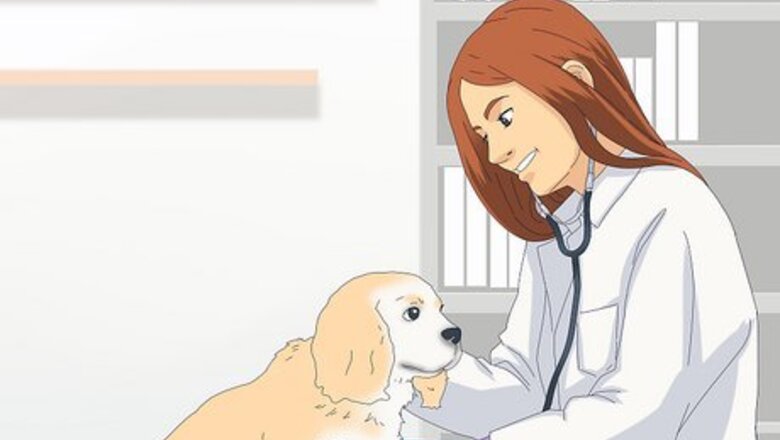
views
- Wait for your dog to reach sexual maturity and run a genetic test for the breed’s common issues before you consider breeding.
- Take a dog to the vet for a full checkup before you actually breed the dog to ensure it’s healthy and able to give birth (or sire pups).
- Breeding itself is very easy—simply introduce the male and female, and allow them to mate naturally at their own pace.
Prep Work
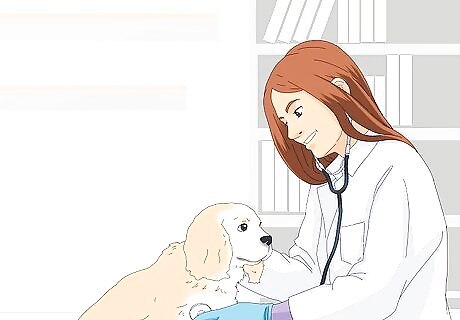
Take your dog to the vet for a general physical examination. Make sure that your dog (and its potential mate) is in good health. A responsible breeder will try to improve the breed, not pass on genetic flaws that will pose health concerns in the next generation. The dam (female) must be in good health to withstand the stresses and rigors of a pregnancy. General indicators of good health include a glossy coat, bright eyes, lack of body odor, and eyes, nose and ears that are free from discharge. A should be able to exercise without coughing, and be free from vomiting or diarrhea. Both dogs should be up to date on their vaccinations.

Test your dog for their breed’s common genetic conditions. Ask the vet run tests for the genetic issues your breed might face. It’s extremely important that you do not breed a dog who is plagued by a major genetic condition facing the breed, since those dogs won’t lead a high quality of life. For example, border collies, Briards, Shetland sheepdogs, and rough collies are all at increased risk of hereditary eye problems. Regardless of how energetic and healthy your dog seems, every breed has genetic health risks. For example, Lhasa Apsos are vulnerable to inguinal hernias and kidney disease, while German Shepherds a prone to hereditary hip dysplasia. If you have a pedigree for your dog, investigate the medical history of the bloodline. Do not breed any dog that’s deaf. A deaf dog is extremely likely to pass the trait on to multiple pups.L

Assess your breed’s temperament before you go forward. A breedable dog should have the best traits of their breed (i.e., a golden retriever should be friendly and love retrieving). If your dog has a problem biting people, they’re scared of other dogs, or they’re aggressive towards strangers, you may not want to breed them. Many common breeds have specific temperament tests, such as a Working Aptitude Evaluation for Dobermans. You should breed a dog who is happy, confident, and obedient around both animals and humans.
Timing
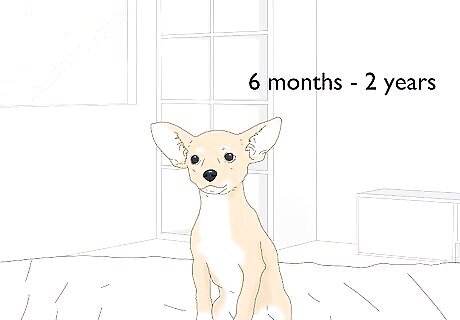
Wait 6 months to 2 years if you want to breed a puppy. Just like human beings, dogs need to reach biological sexual maturity before it's medically safe for them to breed. When this happens depends on the size of the dog. This is especially important for the female dog, as her health might be put at risk by a pregnancy her body is not prepared to carry. Smaller dogs mature faster than larger breeds. A Chihuahua might mature around 6 months, while an Irish Wolfhound might need 2 years to reach maturity. As a rule of thumb, the male dog (the sire) will perform best around 1.5 years of age, while the female dog (the dam) will be healthiest for breeding after their 3rd heat cycle. Do not breed older female dogs (over 4-6 years of age or so). It’s too dangerous.
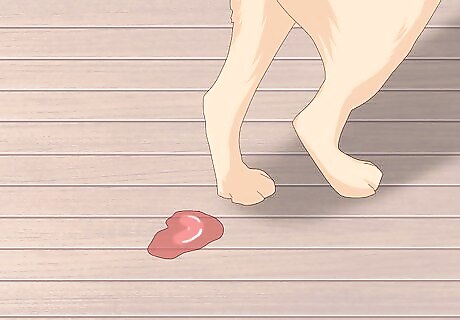
Let the dam go into heat before you breed her with a sire. When females reach sexual maturity, they begin going into heat when they are receptive to mating. Females come into heat about once every 6 months. This is called her "season," and it last for around 21 to 35 days. The signs of being in heat include: Curving her tail to the side when you scratch her backside (revealing her vaginal opening). Twitching or swelling of her vulva. Bloody discharge from her vagina. Note that a bloody discharge in a female that is not due in heat should trigger an urgent vet appointment, because it can be a sign of womb infection and can be serious.
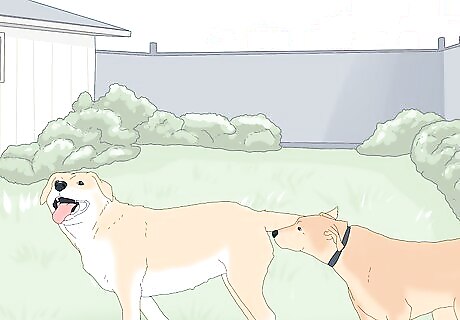
Begin breeding once ovulation occurs around the 11th day of heat. A dog in heat isn’t automatically ready to breed. A dam is most likely to accept intercourse and get pregnant when she ovulates. Look for vaginal discharge that’s thicker and pinker than normal. A dog in heat will also present their hind-side to male dogs. If the two dogs live close to one another, have the female visit every 2-3 days. Be alert to behavior that suggests she's open to his attention. Many breeders will use progesterone test strips to determine when a dog is most breedable. A dam is ready when their blood levels reach 5-6ng/mL. Take your dog to the vet every 2-3 days for a vaginal cytology if the dam’s mate lives far away. The cytology will let you know when they’re ovulating.

Take both dogs to the groomer a few days before mating. Thick tufts of hair can catch or tangle when the dogs are breeding, so take both dogs to a groomer and have them trimmed. A wash will also remove any irritants and ensure the dogs are clean and comfortable. Do this in the week leading up to the actual mating. You may want to explicitly ask the groomer to shave the area directly under the tail if either dog is a long-haired breed.
Breeding
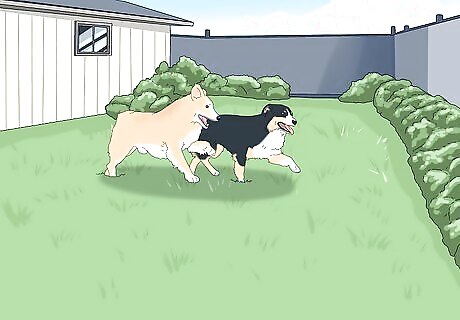
Bring the dam to the sire’s home turf where he’ll be comfortable. Taking a male outside of his normal environment can cause insecurity and distraction for him. Bitches are generally less inhibited by new environments, so take the dam to the sire’s home. Choose a breeding area where the sire will be comfortable. Any private, enclosed space will work. You could set up a small enclosure outside for the dogs if it’s nice out, or use a carpeted basement or garage. Normally, only two handlers need to be present—preferably you and the owner of the other dog. Don’t bring in any strangers who might distract the dogs.

Introduce the dogs slowly and let them get to know one another. Leash both dogs and let them see one another from a distance. Let the dogs relax and let out their excitement before slowly decreasing the distance. At any sign of aggression, pause and wait for the dogs to relax. A sire and an ovulating dam should be more than ecstatic to close the distance. Don’t force the dogs to get close if they seem upset, anxious, or on edge. You may find that the dogs get along just fine, but "as friends." In this case, it's likely the female dog is either not ovulating and not ready to mate, or is not psychologically ready to mate.
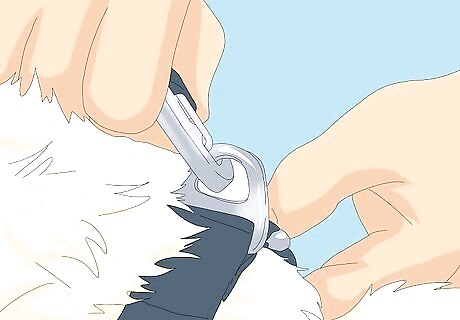
Remove the leashes and supervise the dogs as they get familiar. Don’t leave the dogs alone, even if the process takes a bit. The most important thing when mating dogs is to ensure their safety at all times. This is a natural process for the dogs, but you may need to intervene if the sire is too aggressive or the dam isn’t receptive. Talk to the dogs in a soft, encouraging voice to help them feel secure or comfortable. Never yell at them if you are frustrated or annoyed by any failed mating attempts. An unneutered sire and a dam in heat should make this easy. If one (or both) of the dogs isn’t playing nice, separate them, take them for a walk, and try again. In rare cases, two dogs just may not be right for one another. If they keep refusing to play nice, you may just need to find a new mate for your dog.

Let the dogs start to mate naturally and give them room to get comfy. Let nature take its course—you shouldn’t need to do anything here. An interested sire will sniff the dam's backside, and an interested dam will lift her tail to give him access. The male may also lick the female's vulva and attempt to mount her if she appears willing and ready. Let the sire mount the dam and don’t interrupt them. If the dogs don’t start mating, it’s a major sign something is seriously wrong. Either the sire can’t perform, or the dam isn’t ovulating. Try again in 2-3 days. This whole process usually takes at least 45 minutes (20 minutes at the absolute earliest), so don’t rush it.
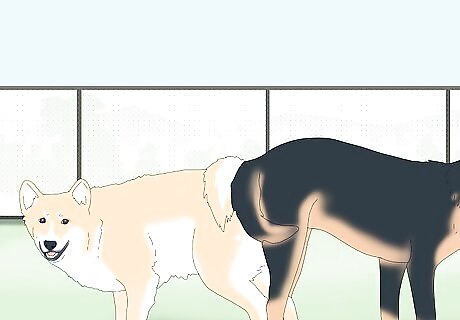
Let the male “tie” to the female and don’t separate the dogs. Once inserted, a part of the sire's penis called the bulbous glandi will swell. This increased size will cause it to lodge inside the female's vagina, and the dogs are now “tied.” The dogs will remain locked together for 10-30 minutes as the male finishes ejaculating. The dogs may scoot or reposition themselves. The female may yelp or the male may look like they’re out of energy. Just let them be. After the sire ejaculates, the swelling will subside and the dam’s vagina muscles will relax. The dogs will then be able to release safely.
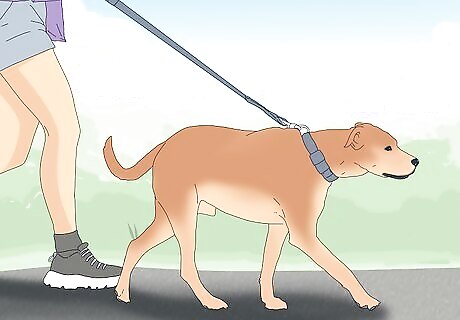
Tend to the dogs immediately after mating. Once the male's penile swelling has reduced and the female's sphincter muscles have loosened, the dogs will separate. Take the dogs apart to keep them from getting overwhelmed. Don’t let the female urinate for about 15 minutes after mating, and just pet and caress her. Walk the male around until his erection goes down and his penis is no longer visible. Keep in mind, the dam may not be pregnant after a single mating session. You may need to repeat this process multiple times.













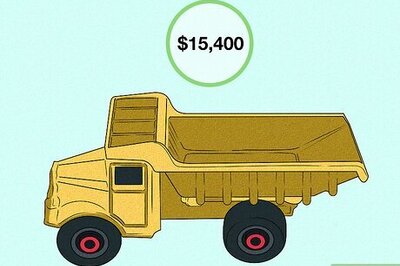






Comments
0 comment